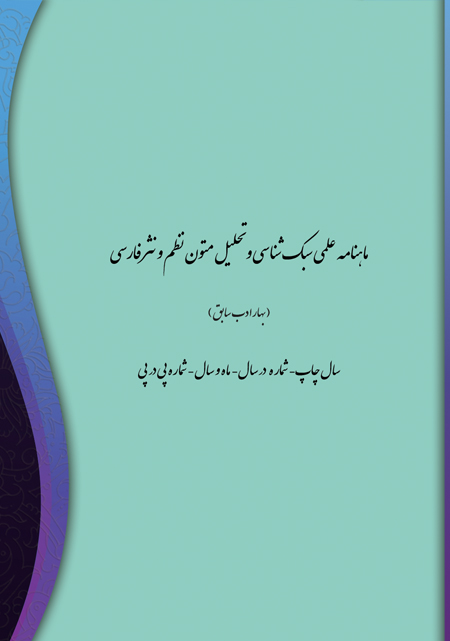- Count View : 8
- آدرس کوتاه شده مقاله: https://bahareadab.com/article_id/1868
- کد doi مقاله: Doi: 10.22034/bahareadab.2025 .18 .7903
Journal of the stylistic of Persian poem and prose
volume Number 18،
number In Volume 6،
،
issue Number 112
Stylistic Analysis of the Novel Azbe by Reza Amirkhani Based on Gerard Genette's Theory
Reza Zandavar , Roqiyeh Sadraei (Author in Charge), Maryam Barzegar
Abstract
BACKGROUND AND OBJECTIVES: The novel Azbe by Reza Amirkhani is one of the contemporary works of fiction that has a creative, nested, and complex narrative structure. The main objective of this article is to discuss and examine the new methods, techniques, and narrative techniques in the story of Azbe, relying on Gerard Genette"s theory and the science of narratology, which can present the structural methods and principles of the story from the beginning to the author"s final goal in a systematic and classified manner.
METHODOLOGY: The study method in this research is descriptive-analytical, and the study of part of the narratives of the novel Azbe is based on the components of order, continuity, time, and frequency based on Gerard Genette"s theory of narratology.
FINDINGS: The narrative in the story of Azbe is in the style of letter writing, therefore, it does not have a specific narrator, and each letter is narrated from the voice of a character. The story begins with a frank letter from a schoolgirl who has lost her parents to the sharp-flying eagle - the pilot of Meshkat - and continues with the efforts of the pilot"s wife to free her from depression by appealing to the old friends of Colonel Morteza Meshkat. In the scenes where Colonel Meshkat"s moods and conditions are described after his death, in the letters that Tayyaba writes to Ms. Teymouri, a comrade of Morteza Meshkat, and in the letters that he exchanges with his other friends, the narrative pace is slow and omissions and abbreviations are not given much attention, and when he intends to neutralize time, he uses dialogue.
CONCLUSION: The main axes of narration in the story of Azbe include order, continuity, mode, frequency, and tone. The temporal order in the story of Azbe is almost considered and there is not much effect of time distortion in its narrative. The narrative is usually slow and accompanied by complete descriptions. Given that the story is not told through the voice of a narrator, there is the least distance between the text and the narration, and the tone of sadness and complaint is used more than other tones.
Keyword
Narratology. Gerard Genette. Contemporary story. Azbe. Reza
- A) Persian Sources
- Ahmadi. Babak (2006). Structure and Interpretation of the Text. Tehran: Markaz Publishing House, pp. 314-316-315-317-291.
- Akhout. Ahmad (1992). Grammar of the Story. Isfahan, Farda Publishing House, pp. 97-201-108-8.
- Amirkhani. Reza (2008). Az beh. Seventh Edition. Tehran: Neistan.
- Eagleton. Terry (2001). An Introduction to Literary Theory. Translated by: Abbas Mokhbar. Tehran: Markaz Publishing House, pp. 146-145-147.
- Bojnordi. Banafsheh and Others (2023). "Narrative and Focusing in the Fictional Literature of the Holy Defense Based on Genet's Theory with Reliance on the Ideological Aspect". Scientific Journal of Persian Poetry and Prose Stylistics (Bahar Adab). Volume 16. Serial No. 91. pp. 17-32.
- Pashaei. Mohammad (2015). "A Study of Narrative in the Novel His Eyes from the Perspective of Gerard Genette". Persian Language and Literature (Former Publication of the Faculty of Literature, University of Tabriz). Year 68. Issue 231. pp. 41-57.
- Perrin. Lawrence (1999). Fiction: Structure, Sound, and Meaning. Translated by: Hassan Soleimani and Fahimeh Esmailzadeh, 3rd Edition. Tehran: Rahnema, p. 20.
- Tassin. Lewis (2011). Theories of Contemporary Literary Criticism. Translated by: Maziar Hosseinzadeh and Fatemeh Hosseini. Tehran: Negah Emrooz, pp. 146-273.
- Todorov. Tzotan (2003). Structuralist Poetics. Translated by: Mohammad Benavi. 2nd Edition. Tehran: Ageh, pp. 57-58.
- Tolan. Michael. Jay (2004). A Critical Introduction - Linguistics on Narrative. Translated by: Abolfazl Harri. Tehran: Farabi Cinema Foundation, pp. 59-61.
- Harri. Abolfazl (2010). "The Correlation of Narrative Levels and Halliday's Metafunctions in the Story of Hassanak Vazir". Literary Studies. (4 (12). pp. 78-69.
- Shlomit Reimon. Kanan (2008). Narrative narrative: Contemporary poetics. Translated by Abolfazl Harri. Tehran: Niloufar, pp. 22-126.
- Genette. Gerard (2019). Narrative discourse; an essay on method. Translated by Masoumeh Zvarian. Tehran: Samat, p. 141.
- Seyed Hosseini. Reza (2005). Literary schools. Fourth edition. 2 volumes. Tehran: Negah, p. 1159.
- Shaeiri. Hamid Reza (2009). Analysis of the semantic sign of discourse. Second edition. Tehran: Samat, p. 6.
- Forster. Edward Morgan (2003). Aspects of the novel. Translated by Ebrahim Younesi. Twelfth edition. Tehran: Negah, p. 94.
- Qasemipour. Qudrat (2008). Time and narrative. Journal of literary criticism. First year. Issue 1. pp. 123-144.
- Coller. Jonathan (2006). Literary Theory. Translated by: Farzaneh Taheri. Second edition. Tehran: Markaz Publishing House, pp. 120-121.
- Golshan. Maryam et al. (2007). “Narrativization of the Dancers Novel Based on the Perspective of Gerard Genette”. Scientific Journal of Persian Poetry and Prose Stylistics. Volume 14. Issue 67. pp. 21-36.
- Lorestani. Zahra and Amiri. Somayeh (2013). “Review and Analysis of Fictional Elements in Reza Amirkhani’s Novels”. Quarterly Journal of Fictional Literature. Faculty of Literature and Humanities, Razi University. First Year. Issue 4. pp. 113-133.
- Lotte. Yakub (2007). Introduction to Narrative in Literature and Cinema. Translated by: Amir Nikfarjam. Tehran: Minoui Kherad, p. 72.
- Makarik. Irnarima (2006). Encyclopedia of Contemporary Literary Theories. Translated by Mehran Mohajer and Mohammad Nabavi. Tehran: Ageh Publications, p. 149.
- Wallace. Martin (2003). Theories of Narrative. Translated by Mohammad Shahba. Tehran: Hermes, pp. 144-143-91.
- Webster. Roger (2003). An Introduction to the Study of Literary Theory. Translated by Elaheh Dehnavi. Tehran: Farhang ve Ershad-e-Islami Publications, p. 55.
- Genette. Gerard (1980). Narrative Discourse: An Essay in method. Trans jane. E. Lewin. Cornell university press.

